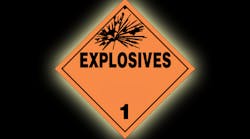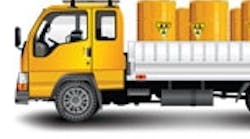The identification of a hazardous material with its proper classification is essential for safe handling, transport, emergency response and product storage. The United Nations (UN) and others have participated in the development of a common classification system for use in transportation. This system consists of nine (9) classes and a varying number of divisions within those classes.
Properly identifying the hazards and correct classification are required before materials are placed in transport. In addition, the shipper must determine that the proper packaging or container is used (49 CFR 173.22). Unrecognized hazards can result in catastrophic events affecting shippers, carriers, the public and those who use or handle these substances.
Munitions, pyrotechnics and other explosive products are expected to have inherent explosive hazards. However, this can also be true of many other chemicals used for completely unrelated purposes.
At times, a manufacturer or importer may produce a high-energy or explosive product without intending to produce a high-energy product or explosive. Even so, no explosives can legally move over the nation’s highways, railways, waterways or airways without DOT approval. A DOT approval is often referred to as a Competent Authority Approval or letter.
How to Attain Competent Authority Approval
In the UN system of classifying hazardous materials, a “Competent Authority” is the designated final word on UN Classification for International Shipping within each country. In the U.S., the “Competent Authority” is the Associate Administrator for Hazardous Materials Safety, a senior position within PHMSA (US DOT Pipeline and Hazardous Materials Safety Administration). The regulating applicable document is the most current version of 49 CFR parts 100-185, also known as the Hazardous Materials Regulations (HMR).
Competent authority approval must be obtained for transportation of the following:
- Explosives
- Propellants
- Pyrotechnics, including Fireworks
- Explosive precursors (certain oxidizers, for bulk transport)
- Chemical oxygen generators
- Desensitized Explosives
- Blasting agents
- Some Self-reactive materials
- Some Organic peroxides
To apply for an approval for transporting an explosive (and the associated EX number) one must first have the explosive examined in accordance to 49 CFR 173.56. To facilitate this process and to assure consistency and competency, the U.S. DOT has approved several laboratories to examine these energetic materials and provide a recommendation to the DOT as to the proper shipping name and UN/DOT classification of the material. The DOT will then review the lab report and will normally issue an EX number (explosives approval number) for that material. A list of the approved labs and contact information may be found on the DOT’s Website.
It is incumbent on those that manufacture, import, repackage, or otherwise offer for transport hazardous materials to understand the UN/DOT hazmat system and to verify that the hazardous materials they ship or transport are properly classed, packaged and labeled. By doing so, we protect our jobs, our communities and the transportation network.
Thaddeus C. Speed is technical director at Safety Consulting Engineers, a DEKRA company. He can be reached at [email protected] or 847-925-8100.




